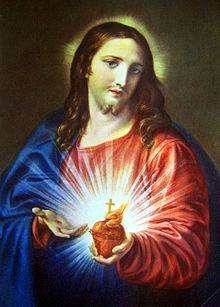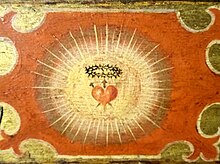
Back قلب يسوع الأقدس Arabic Sagrat Cor de Jesús Catalan Nejsvětější Srdce Ježíšovo Czech Sacré coeur Danish Heiligstes Herz Jesu German Sankta koro de Jesuo Esperanto Sagrado Corazón de Jesús Spanish Jesusen bihotz guztiz santu Basque قلب مقدس Persian Pyhä sydän Finnish
The Sacred Heart of Jesus | |
|---|---|
 | |
| Venerated in | |
| Feast | Third Friday after Pentecost |
| Attributes | Burning bloodied heart, surmounted with cross and thorns |
| Influenced | First Fridays Devotion |

The Most Sacred Heart of Jesus (Latin: Cor Jesu Sacratissimum) is one of the most widely practised and well-known Catholic devotions, wherein the heart of Jesus Christ is viewed as a symbol of "God's boundless and passionate love for mankind".[1] This devotion to Christ is predominantly used in the Catholic Church, followed by high church Anglicans, and some Western Rite Orthodox. In the Latin Church, the liturgical Solemnity of the Most Sacred Heart of Jesus is celebrated the third Friday after Pentecost.[2] The 12 promises of the Most Sacred Heart of Jesus are also popular.
The devotion is especially concerned with what the church deems to be the long-suffering love and compassion of the heart of Christ towards humanity. The popularization of this devotion in its modern form is derived from a Roman Catholic nun from France, Margaret Mary Alacoque, who said she learned the devotion from Jesus during a series of apparitions to her between 1673 and 1675,[3] and later, in the 19th century, from the mystical revelations of another Catholic nun in Portugal, Mary of the Divine Heart, a religious sister of the congregation of the Good Shepherd, who requested in the name of Christ that Pope Leo XIII consecrate the entire world to the Sacred Heart of Jesus. Predecessors to the modern devotion arose unmistakably in the Middle Ages in various facets of Catholic mysticism, particularly with Gertrude the Great.[4]
- ^ "Opening for the Year of Priest on the 150th Anniversary of John Mary Vianney". vatican.va. Jun 19, 2009. Archived from the original on December 24, 2017.
- ^ "Solemnity of the Sacred Heart of Jesus". Archived from the original on August 29, 2018.
- ^ Jean Ladame, Marguerite–Marie, La sainte de Paray, Éditions Resiac, 1994 ISBN 2-85268-118-8
- ^ Bainvel 1910, II. Historical Ideas on the Development of the Devotion, para (3–4).